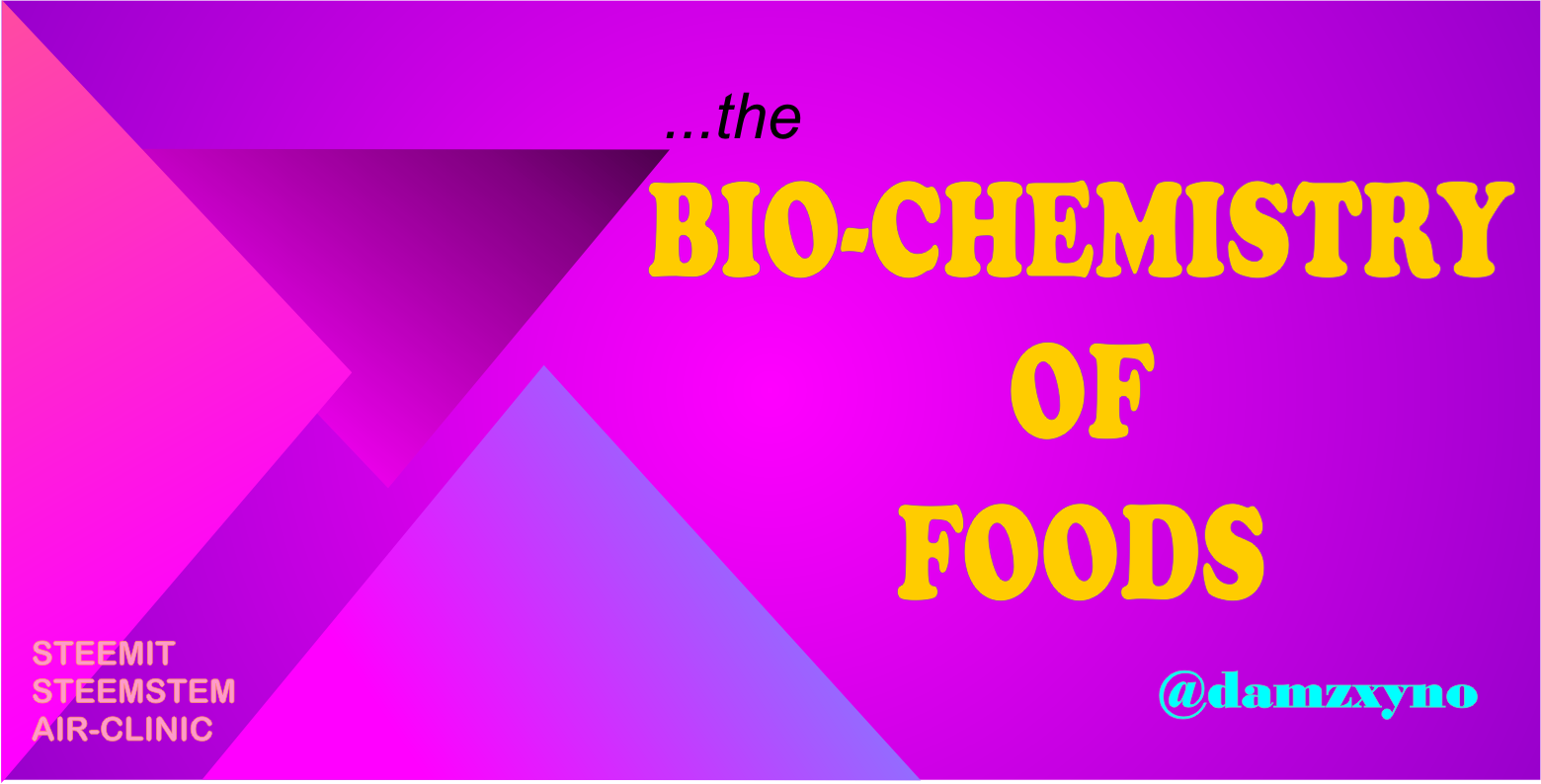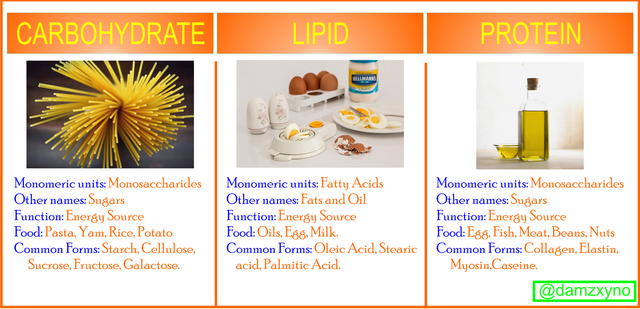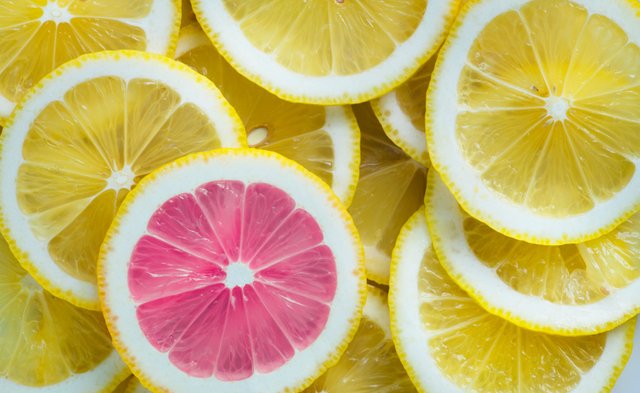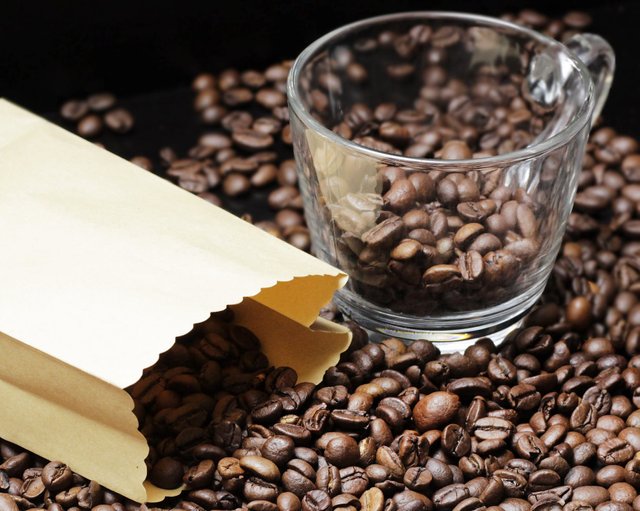Introduction to the Biochemistry of Food
Moving across different geographical regions of the earth, you get to come across different sights and cultures; You encounter different kinds of dressings, languages, musics, dances as well as food. I was in the hospital with my uncle when the doctor had to break some news to him, he had to stop some lifestyles, habits as well as some foods. I ended up listening to his laments as we journeyed back home.
Food is a vital part of life, no organism can do without them, even babies in the womb are dependent on every food the gravid mother takes. Food are not just physical things which help replenish our energy level, they are actually chemical substances made up of molecules trapping huge sum of energies in their chemical bonds. The food we eat end up becoming part of our body and mind, we are what we eat.
In my today's post, I'll be explaining the biological but most importantly, biochemical approach to foods.

Food sources by nature are living things, majorly plants. The leaves, stems, fruit and roots of plants have been consumed as food by man since the beginning of existence. Also, flesh, bones, blood and milk are food gotten from animal sources and used as food in different cultures. Recently, there are synthetic food substances available in the market. These food substances are produced indirectly from living things, they have undergone a long and steady process that these food can no longer by tagged as organic.

Green plants have Chlorophyll which enables them absorb sunlight for production of energy
Image is sourced from pexels.com under CC0 licence.
Food consumption are not limited to humans, all living organism consume food substances. Animals, especially vertebrates are usually classified based on the kind of food they eat. This classification system places animals in one of the three groups of animal which includes: Herbivores, Omnivore and Carnivores. Herbivores are animals that consumes plants only. Goats, cows, sheep and some birds can be classified as herbivores. Carnivores consume the flesh of other animals, they do not eat plants or herbs, these animals include lions, tigers, leopards etc. Omnivores consume both flesh and herbs. Humans are the number one examples of animals under this group,other animals include dogs, hens etc.
Food Chemistry
There is a chemistry to the diversity of food shapes, sizes, colors, texture, smell, taste as well as other characteristics feature that makes a food different from another. Also, cooking can be classified as chemistry in action. A good example if boiling of egg, the protein of the egg loose their normal structure as well as their function when heated, the proteins begin to stick together to form a mass, this process is called coagulation.

Tastes of foods are determined by the bio-molecules present in the food and the presence or absence of sensors in the organism consuming the food. Sweetness of fruits is usually due to the presence of fructose or sucrose in those food. There is abundant sucrose detectors on the tongue which aid one in detecting sweetness of these food. Sometimes, these food taste are altered by volatile chemicals present in the food.
These chemicals are very volatile and they get detected by the nose olfactory system, this enhances the perception of the food. Example of such food flavors manzanate in apple, isoamyl acetate in banana and limonene in orange.
If one is to close his nose while chewing a food, one would only be limited to perceiving the food's texture and taste(sweetness, bitter, sour etc) but might find it hard being specific what one is eating. A food with good flavor will be perceived as being better than a food with more sucrose, in most cases, people will testify that the better scenting food is more sweeter than the food with more sucrose. Sour taste of food is due to presence of acids. Taste is also determined by presence of salts, bases, water among others.

Carbohydrate are also known as sugars and are a major of every day diet, however, imbalance in protein-carbohydrate intake over a long period of time can lead to kwashiorkor (protein malnutrition) in children. Carbohydrate can be simple or complex, simple carbohydrates consist of only one molecule of sugar, examples include galactose, glucose, fructose, ribose, among several. Complex sugars are made up of two or more monomeric unit. A carbohydrate having two monomeric units chemically combined together is known as a disaccharide and is a dimonomeric molecule. Carbohydrate could be as complex as starch which contain several molecules of glucose. Starch is the major storage form of energy in plants. Yam tubers, maize, cassava are good sources of starch. Cellulose also contain glucose molecules but are combined in a different chemical co-ordination compared to starch. Organism such as bacteria and cattle have the ability to utilize the energy stored in cellulose because they can digest it. Human lack the enzyme responsible for cellulose digestion.
Proteins are made up of amino acids. There are about 500 amino acids known to man but only 20 take part in protein formation. Protein are essential for structural integrity of tissues as well as to diversify the functions of an organism. Keratin is a protein molecule found in the skin, it gives structural to the cells of the skin to perform its function as well as stand harsh environmental conditions. A good proportion of enzymes in the body are proteins, the oxygen transporting pigment in the blood is made up of protein. Proteins are essential to life. The are important in building up tissues and repairing them when they are old or damaged. Proteins are essential for growth and development. Plants and animals contain protein in varying amounts.
Lipids are substances that are not protein and not carbohydrate. They exist in solid forms as fats and in liquid forms as oil. They are an essential part of life. The body fat is made up of triacyglyceride which help the body store fats as well as serve as an insulator. Women have more fat tissue compared to men and are more resistant to cold than the men. Coconut oil, butter, palm oil, Fish oil are a good source of oil. Most food we eat also contain oil in very little quantities.
Food Acid

All food are either basic, acidic or neutral. Lemon fruit is acid, it contains the acid Citric as well as Malic. Coloration is due to anthocyan
Image is sourced from pexels.com under CC0 licence
Acids are present in foods in varying quantities. Unripe fruits contain more acids than the ripe ones. These acids contributes to the taste of the food as well as serve as preservatives and as anti-oxidants. These acids are intentionally used as materials in food industries for enhancing the taste and shelf life.
| Acid | Chemical Formula | Food |
|---|---|---|
| Acetic Acid | C2H4O2 | Vinegar, Mustard, Mayonnaise |
| Ascorbic Acid | C6H8O6 | Kiwi, Mango, Pawpaw |
| Citric Acid | C6H8O7 | Citrus fruits, Pineapple, Tamarind |
| Glutamic Acid | C6H8O6 | Turkey Breast, Avocado, Beef |
| Fumerate | C4H4O4 | Majorly processed foods |
| Lactic Acid | C3H6O3 | Yogurt, Sour Milk |
| Malic Acid | C4H6O4 | Leches, Water Melon, Mango |
| Palmitic> Acid | C16H32O2 | Red meat, Corn oil, Butter |
| Tartaric Acid | C4H6O6 | Apricots, Apple, Banana |
Citric acid is also known as vitamin C and is essential in fighting infections. Lactic acid is an acid present in milk and higher quantity in sour milk. Casein is a protein present in milk and the presence of lactic acid causes it to coagulate, this is what causes the sourness of milk. There are other acid present in food and they can be classified as proteins, carbohydrate or lipids. Glutamic acid is an amino acid, a monomeric unit of protein, Palmitic acid is also a lipid, a derived lipid or fatty acid and Lactic acid is a carbohydrate molecule.
Energy in food

Coffee beans are rich source of caffeine, a stimulant of the nervous system that causes the heart to beat faster among other physiological process to create alertness and releases more energy at the body's disposal
Image is sourced from pexels.com under CC0 licence.
Energy is stored in the bonds of chemical molecules. They are stored in a more utilizable form in the chemical bonds of the molecules of food. These chemical energies are known as calories. This is the energy that are allows us to do everyday activities such as walking, jumping and even working. Carbohydrates, proteins and lipids are bio-molecules that store energy in their bond but the body uses these compounds more differently. Carbohydrates are the preferred energy source of the body, lipids are secondary energy source and used in place of depletion in body energy. Proteins are used in building up body tissues as well as repair them when they are worn out.
In multicellular organisms such as man, there are enzymes responsible for breaking down food molecules into smaller molecules that is readily absorb-able by the body tissue and cells. The enzymes that breakdown food during consumption are known as digestive enzymes. Carbohydrates molecules are broken down to their simple monomeric units, proteins to amino acids and lipid to fatty acids. Humans cant digest cellulose in food because they do not have the enzymes to break them down. The kind of food an animal takes depends on its geographical location, ability to get the food, ability to digest it as well as presence of taste.
Excess calories in the body are stored in chemical bonds for future and later use. Glycogen and triglycerides are the compound in which the human body and many animals stores excessive energy for future use.
Some disease however need special food intake or restriction. Diabetes for example is a disease of blood sugar. There is a restriction in carbohydrate-rich food intake for diabetic patients, as well as spicy foods for diabetic patient. In case of ulcer, the doctor would advice more water intake as well as foods rich in fatty acids.
Question for the day: What do you think is responsible for fruit ripening as well as food decay?
On my next post, we'll be going further into the chemistry of food, please follow me @damzxyno. As you all know, you are what you eat, hence you need to know what you eat, what they are composed of and how to balance them. Cooking classes is not enough, apply some science, thank you!!
You are Awesome!!!
- FoodSources, Production Taste perception, Cuisine...
- Organic FoodsSources, e
- Food FlavorsFlavor is a product of taste and smell
- CarbohydrateEnergy giving molecules.
- ProteinsBody building molecules.
- LipidsMolecules existing either as fats or oils


Congratulations! This post has been upvoted from the communal account, @minnowsupport, by Damzxyno from the Minnow Support Project. It's a witness project run by aggroed, ausbitbank, teamsteem, theprophet0, someguy123, neoxian, followbtcnews, and netuoso. The goal is to help Steemit grow by supporting Minnows. Please find us at the Peace, Abundance, and Liberty Network (PALnet) Discord Channel. It's a completely public and open space to all members of the Steemit community who voluntarily choose to be there.
If you would like to delegate to the Minnow Support Project you can do so by clicking on the following links: 50SP, 100SP, 250SP, 500SP, 1000SP, 5000SP.
Be sure to leave at least 50SP undelegated on your account.
Very great artcile full of informations, i'm glad that i'm reading this :) and about your question, i think that:
The high temperature is indirectly responsible for food decay, as food is fast festering in the summer compared with winter, because increasing temperature triggers chemical and biological reactions, making food rot faster. that's why we put fruit and vegetables in the fridge because the cold slows down the growth of bacteria.
Thank you for sharing this, keep doing the good job ;)